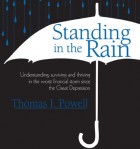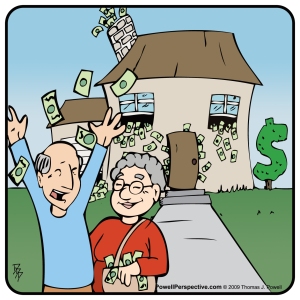 As our economy slowly recovers, many investors are concerned with recouping the money they lost during the crisis. Pulling your funds out of investments all together will do nothing to bulk up your savings, while sinking your money into risky funds can do further damage. So, with black-and-white options not offering solutions, where can investors put their money to work?
As our economy slowly recovers, many investors are concerned with recouping the money they lost during the crisis. Pulling your funds out of investments all together will do nothing to bulk up your savings, while sinking your money into risky funds can do further damage. So, with black-and-white options not offering solutions, where can investors put their money to work?
Many investors are turning to investments that they feel are safe, such as bank CDs or money market mutual funds. The problem with these “safe havens” lies in the low returns. “The average money market fund yields .05 percent, or $5 on a $10,000 deposit.” With rates of return this low, these investments may not be able to keep up with inflation, let alone fill the gaps left by the losses experienced over the last 24 months.
Another option is to do nothing. Yvon Chouinard, founder of the Patagonia sports outlets, says, “There’s no difference between a pessimist who says, ‘Oh it’s hopeless, so don’t bother doing anything’ and an optimist who says, ‘Don’t bother doing anything, it’s going to turn out fine anyway.’ Either way, nothing happens.” The idea of holding on to your portfolio “as is” and wishing for the stocks you currently hold to rebound may work in some instances. But, if time turns out to be your enemy, your retirement years will be funded only by the amount you currently have, minus the effects of inflation.
As investors actively search for ways to re-energize their portfolios, many are returning to real estate. The real estate market is hovering around the bottom, interest rates remain near record lows and a large inventory gives buyers an abundance of options. On the residential side, many foreclosures and bank-owned properties can now be purchased for a fraction of their value. The same opportunities are becoming available in commercial real estate as owners are unable to pay off or refinance their loans.
As I have mentioned before, real estate can help your portfolio win the battle over inflation. Real estate’s value will return at some point.
Shaking Our Stone Age Tendencies
Letting our emotions dictate our investment decisions is a risky behavior. Out of instinct, we all get emotional when we earn or lose money. It is in our wiring to feel connected with the money we have accumulated. We tend to panic when our money is in jeopardy.
We make a connection between money and safety. Psychology suggests that we are programmed to protect our safety the same way our ancient ancestors were. Even though we encounter vastly different problems than our ancestors did, we still attempt to solve them in the same way. Moving with the herd used to be crucial to staying alive. Today however, moving with a herd of investors can weaken your portfolio. Pushing money into an investment simply because the majority of others are is usually the exact opposite of what you should be doing.
In the same vein as the herd behavior, is our tendency to make investment decisions based on past success. Just because a strategy worked in the past does not necessarily mean it will work in the present. Markets change dramatically from week to week. Strategies you used in the Dotcom boom of the late nineties may lead to an unpleasant outcome in today’s market. Sticking to market fundamentals is one thing, but taking on blind risk a second time because it worked out the first, is nothing more than a gamble. It is the same concept behind betting on red because the roulette ball fell in a red pocket the previous spin. No matter what your past performance, prudent due diligence is always necessary to gauge the current market trends, analyze risk and make sound investment decisions.
I have encountered a number of studies that suggest we remember the bitter feeling of losing money more acutely than the feelings we have when we earn the same amount in an investment. A few lousy investment decisions and an investor can be turned off indefinitely. It is important to learn from our mistakes and use the knowledge to our advantage. Our emotions can lead us to make decisions that, in hindsight, are horrible ideas. A bad decision is bad no matter what the outcome. Making money out of an emotional decision is lucky, but the decision itself was still the wrong one.
There is no way to completely escape our tendencies to invest based on emotion. But, by being aware of the negative impact our emotions have on our investment decisions, we can limit their influence. Wise approaches such as hiring investment professionals, practicing prudent due diligence and planning sound exit strategies can all help us become better investors.
Bank Closures v. the FDIC
Last week, federal regulators seized seven more banks- three in Florida and one each in Georgia, Minnesota, Illinois and Wisconsin. The bank failures brought the year’s total to 106, which is the most since the savings and loan debacle brought about 181 failures in 1992. Plus, with 416 banks on the FDIC’s watch list, the number of bank failures is expected to rise before the end of the year. With bank closures quickly absorbing millions of dollars from the FDIC’s Deposit Insurance Fund, is it possible that our savings accounts are realistically still protected?
The FDIC operates like a basic insurance policy, except banks are the customers instead of individuals or groups of individuals. Banks pay insurance premiums to the FDIC in exchange for its commitment to protect their depositors’ money. In the late 1920s, when banks closed at an alarming rate, depositors had no protection from bank failures. Between 1929 and 1933, banks lost an estimated $1.3 billion of their customers’ money. Today, the FDIC protects several trillion dollars worth of deposits. But as of June, it only had $10.4 billion in its deposit insurance fund—down from about $45 billion earlier this year.
The FDIC’s reserves have quickly depleted as the cost of bank failures outpace the fees the corporation collects. Last month, as bank closures continued to mount, the FDIC’s board of directors considered four ways to bulk up the insurance fund. The options considered were: borrow from healthy banks, borrow from the treasury, levy a special fee on banks or collect regular premiums early.
Borrowing from healthy banks would reduce the amount of money available to the private sector. Borrowing from the Treasury could send the wrong message to the public and have adverse effects on the banking industry. Levying a special fee on banks could push those on the edge into failure. The last option, albeit not particularly attractive either, is to collect regular premiums early. Deciding to follow through with this option, the FDIC stated it “adopted a Notice of Proposed Rulemaking that would require insured institutions to prepay their estimated quarterly risk-based assessments for the fourth quarter of 2009 and for all of 2010, 2011 and 2012.” The press release indicated that the FDIC estimates prepayments will total approximately $45 billion.
Once approved, the proposed prepayments could give banks a bill for three years of premiums by the end of this year. While the requirement would put banks in a tough situation, the FDIC does not seem to think banks will find it too cumbersome. The FDIC believes that “the banking industry has substantial liquidity to prepay assessments.” As stated in the press release, “As of June 30, FDIC-insured institutions held more than $1.3 trillion in liquid balances, or 22 percent more than they did a year ago.”
The FDIC does have the capability to protect our deposits. However, initiatives that charge banks three years’ worth of premiums at once could help the FDIC weather an onslaught of bank closures without requiring the government to print more money…I hope.
All My Best,
Thomas J. Powell








